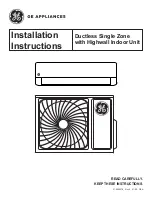
9
ROUTING CONTROL POWER WIRES — Form a drip--loop
with the thermostat leads before routing them into the unit. Route
the thermostat leads through grommeted hole provided in unit (see
Fig. 10) into unit control box. Connect thermostat leads to unit
control power leads as shown in Fig. 13.
Route thermostat wires through grommet providing a drip--loop at
the panel. Connect low--voltage leads to the thermostat as shown in
Fig. 13.
The unit transformer supplies 24--v power for complete system.
Transformer is factory wired for 230--v operation. If supply voltage
is 208 v, rewire transformer primary as described in the Special
Procedures for 208--v Operation section below.
SPECIAL PROCEDURES FOR 208--V OPERATION
ELECTRICAL SHOCK HAZARD
Failure to follow this warning could result in personal
injury or death.
Before performing service or maintenance operations on the
system, turn off main power to unit and install lockout tag.
!
WARNING
1. Remove wirenut from connection of ORG wire to BLK
wire. Disconnect the ORG transformer--primary lead from
the BLK wire. Save wirenut. See unit wiring label.
2. Remove the wirenut from the terminal on the end of the
RED transformer--primary lead.
3. Save the wirenut.
4. Connect the RED lead to the BLK wire from which the
ORG lead was disconnected. Insulate with wirenut from
Step 1.
5. Using the wirenut removed from the RED lead, insulate the
loose terminal on the ORG lead.
6. Wrap the wirenuts with electrical tape so that the metal
terminals cannot be seen.
Indoor blower--motor speeds may need to be changed for 208--v
operation. Refer to Indoor Airflow and Airflow Adjustments
section.
PRE--START--UP
FIRE,
EXPLOSION,
ELECTRICAL
SHOCK
HAZARD
Failure to follow this warning could result in personal
injury or death and/or property damage.
1. Follow recognized safety practices and wear protective
goggles when checking or servicing refrigerant system.
2. Relieve and recover all refrigerant from system before
touching or disturbing anything inside terminal box if
refrigerant leak is suspected around compressor
terminals.
3. Never attempt to repair soldered connection while
refrigerant system is under pressure.
4. Do not use torch to remove any component. System
contains oil and refrigerant under pressure.
5. To remove a component, wear protective goggles and
proceed as follows:
a. Shut off electrical power to unit and install
lockout tag.
b. Relieve and reclaim all refrigerant from system
using both high-- and low--pressure ports.
c. Cut component connecting tubing with tubing
cutter and remove component from unit.
d. Carefully unsweat remaining tubing stubs when
necessary. Oil can ignite when exposed to flame.
!
WARNING
Use the Start--Up Checklist supplied at the end of this book and
proceed as follows to inspect and prepare the unit for initial
start--up:
1. Remove all access panels.
2. Read and follow instructions on all DANGER, WARNING,
CAUTION, and INFORMATION labels attached to, or
shipped with, unit. Make the following inspections:
a. Inspect for shipping and handling damages such as
broken lines, loose parts, disconnected wires, etc.
b. Inspect for oil at all refrigerant tubing connections and
on unit base. Detecting oil generally indicates a
refrigerant leak. Leak--test all refrigerant tubing
connections using electronic leak detector, or
liquid--soap solution. If a refrigerant leak is detected, see
following Check for Refrigerant Leaks section.
c. Inspect all field-- and factory--wiring connections. Be
sure that connections are completed and tight.
d. Inspect coil fins. If damaged during shipping and
handling, carefully straighten fins with a fin comb.
3. Verify the following conditions:
a. Make sure that outdoor--fan blade is correctly positioned
in fan orifice. Top edge of blade should be 3.125 in.
down from condenser outlet grille. See Condenser Fan
section.
b. Make sure that air filter is in place.
c. Make sure that condensate drain pan and trap are filled
with water to ensure proper drainage.
d. Make sure that all tools and miscellaneous loose parts
have been removed.
50Z
P






































